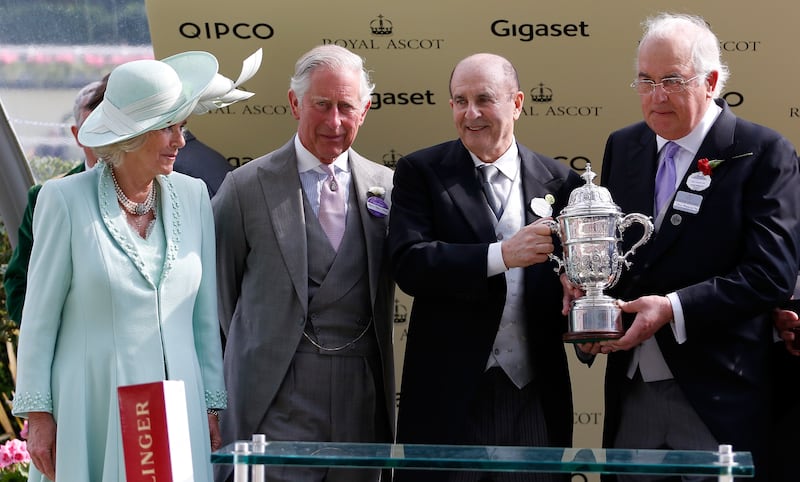Within weeks, billionaire John Magnier, best known for his horse racing interests, will have freedom to take one of Britain’s finest treasures abroad, or else to enjoy a £50m (€56.2 million) cheque from the National Portrait Gallery in London.
It seems unlikely the gallery will be able to raise the £50m it needs to buy the Sir Joshua Reynolds’ painting Portrait of Omai, which Magnier bought in 2001, by the deadline of March 10th.
The 1775 painting is one the United Kingdom’s national treasures, showing Omai, a South Sea islander brought back to England in 1774 by a sea captain who had sailed with the explorer Captain James Cook.
Soon, Omai was the talk of London society, accommodated by aristocracy and brought to meet to King George III before he returned to the South Seas with Cook on the explorer’s third voyage in 1776.
Protestant churches face a day of reckoning with North’s inquiry into mother and baby homes
Pat Leahy: Smart people still insist the truth of a patent absurdity – that Gerry Adams was never in the IRA
The top 25 women’s sporting moments of the year: 25-6 revealed with Mona McSharry, Rachael Blackmore and relay team featuring
In a statement to The Irish Times this week, the National Portrait Gallery said “almost half” the amount had been raised. However, that has been the position for some time, and the gallery has been fundraising for almost a year.
Unless the British government or a rich philanthropist steps in and makes up the difference, the 7ft by 5ft portrait of the young Tahitian will finally be given an export licence, packed in a crate and flown to Ireland. It may hang in Coolmore Stud in Co Tipperary, or the Magniers could put the painting on the international market, where it could fetch in excess of £50m. The well-endowed Getty Museum in Los Angeles has already shown an interest.
The businessman and his wife, Susan, are known to be shrewd art investors. In 2003, they bought Nu couché (sur le côté gauche) by Modigliani at Christie’s in New York for $27m (€25.3m). The reclining nude was re-sold in May 2018, for $157.2m. As the work by the Italian painter was loaned to the National Gallery of Ireland for six years, no capital gains tax was payable.
Ironically, when the 18th-century Omai painting was put on the market in 2001, it was because the then owner, Simon Howard, faced a huge tax bill after his divorce. It had hung for over 200 years in Castle Howard in Yorkshire, where the TV adaptation of Brideshead Revisited was filmed.
Omai was bought at Sotheby’s for £10.3m by the British art dealer Guy Morrison, who then sold it to the Swiss company Settlements SA, which was controlled by Magnier.
At the end of 2002, an application was made by William Fry solicitors in Dublin for an export licence. When the owner of a culturally important artwork wants to take it out of the UK, a licence must be sought, and the government can impose a temporary stop, to allow British buyers a chance to purchase it for an agreed price. This is what Tessa Blackstone, the then British arts minister, did in December 2002, putting a value of £12.5m on the Reynolds’ painting. This sum was offered by an anonymous ‘white knight’, who tried to secure Omai for the Tate gallery. But Magnier turned down the offer, and the minister refused him an export licence.
With the painting languishing in storage, a deal was worked out between the Tate and businessman Lochlann Quinn, then chairman of the National Gallery of Ireland, to loan it to Dublin for six years. That length of time was an odd coincidence. Under Section 606 of the Taxes Consolidation Act 1997, if the owner of an artwork worth more than €32,000 loaned it to an Irish museum for exactly six years, they did not have to pay 20 per cent capital gains tax when it sold. Of course, if Magnier is not tax resident in Ireland, the point is academic.
When news of the Omai loan emerged in 2005, the Department of Finance changed the required length of the loan from six years to 10, but it confirmed that the change would not be applied retrospectively. In a statement in February 2006, just after the amendment was made, the Department said: “There was a concern that people were going to start using this [Section 606] as a tax-avoidance measure.”
Omai returned to Britain, as agreed, in 2011. The following year its owner applied for a temporary export licence to take the painting out of the UK for 15 months, but the arts minister, Ed Vaizey, refused. “Joshua Reynolds’ Omai is an outstanding work of art which has already spent more than five years overseas and I do not want to see the regime being undermined by repeated use of temporary licences,” he said at the time.
In June 2020, a fresh application for a permanent export licence was made, and considered the following June by the independent reviewing committee which advises the secretary of state on whether a cultural object is of national importance.
“The painting seemed to us to be quintessentially of heritage status, and we believe every chance should be given for the nation to secure it this time round, which will most certainly be the last,” the reviewing committee wrote in its latest annual report. “We have been reassured that the owners will accept a matching offer and we have no reason to doubt this.”
The value of Omai shown on the export licence application was £50m, a figure independently confirmed by the British art dealer Anthony Mould, and then accepted by the secretary of state as being its fair market price.
A decision on the licence was deferred for four months, to see if anyone in Britain would express a serious intention of buying it. When the National Portrait Gallery said it intended to do so, the decision on the licence was deferred for a further eight months, to March 10th. The Magniers have allowed Omai to be displayed privately during this period, so potential donors can view it.
The Art Fund, a charity, is working with the National Portrait Gallery to raise the £50m and has awarded an “exceptional grant” of £2.5m towards the purchase. “Thanks to many generous trusts, foundations and individuals, almost half the £50 million needed has now been raised,” it said this week. “There remains a very ambitious challenge, but this is a unique chance to bring a painting of outstanding international significance into public ownership and share it across the UK. In the words of Nicholas Cullinan, director of the National Portrait Gallery, this work is ‘amongst the most important acquisitions we as a nation could ever make and will be remembered for generations to come’.”
The charity does not agree that fundraising has stalled. A spokeswoman said: “Art Fund has received over 900 individual donations from members and supporters since December, and we are continuing to work closely with the National Portrait Gallery to rally support.”

The British government-funded National Heritage Memorial Fund (NHMF) has made a “provisional” offer of £10m towards the acquisition, but stresses that “a final decision has not yet been made”. The fund revealed that one proposal was for the National Portrait Gallery and the Getty Museum to jointly buy Omai, and rotate its display between London and New York. “NHMF’s view was that we would wish the painting to be fully accessible to a UK audience,” it said.
In practical terms, packaging Omai and flying it halfway around the world every six months would have been cumbersome, expensive and potentially damaging to a 250-year-old oil painting.
If the London gallery does raise the £50m, Magnier could refuse to sell, but then the arts minister would almost certainly refuse an export licence and Omai would go back into storage. If the businessman reapplied within 10 years, the application could be refused without a deferral period. We should expect, then, that the Magniers will sell. But is the gallery likely to reach its target?
The controversy around the art philanthropy of the Sackler family – who are at the heart of the opiate drugs scandal in the United States – has made curators more wary of accepting large donations, so the potential pool of donors is smaller than before.
The war in Ukraine has removed the possibility of tapping up wealthy Russian donors. An expensive intervention by the British government would seem unlikely, given the state of the economy, but equally it could face heavy criticism if Omai permanently leaves its shores.
The reviewing committee has called it “arguably the greatest portrait by one of the greatest British portraitists”. Last December, the arts minister Lord Stephen Parkinson commended the National Portrait Gallery for “all it is doing to keep this spectacular work in this country for the public to enjoy and learn from”. Yet he pointed out that only a third of the cultural items placed under an export ban end up being bought and kept in the UK.
[ Locals oppose Magnier plan for hotel extension close to the Rock of CashelOpens in new window ]
Omai represents an unlikely reversal of fortune. Throughout the 1970s and 80, British buyers stocked up on art treasures from historic Irish country houses such as Malahide Castle and Adare Manor. Now the country could be about to lose one of its own, and to the son of a Cork farmer who had to leave school at 15.
The Magniers like to name horses after their favourite painters. There’s been Munnings, Yeats and Amedeo Modigliani. What odds on a Joshua Reynolds eventually racing in the Coolmore colours?
A spokesman for Coolmore declined to comment.











